Everything You Need to Know About the Raspberry Pi 5 Board
The Raspberry Pi 5 represents a major leap forward in the evolution of the Raspberry Pi platform. As the most powerful single-board computer (SBC) ever released by the Raspberry Pi Foundation, the Pi 5 introduces significant improvements in CPU performance, GPU capability, I/O bandwidth, and expandability — making it a highly viable solution for everything from embedded systems and retro gaming to edge AI, robotics, and home lab servers.
1. Raspberry Pi 5 – Key Specifications
| Feature | Details |
|---|---|
| CPU | 64-bit Quad-core Arm Cortex-A76 @ 2.4GHz |
| GPU | Broadcom VideoCore VII (OpenGL ES 3.1, Vulkan 1.2 support) |
| RAM Options | 4GB or 8GB LPDDR4X-4267 SDRAM |
| Storage | microSD slot (UHS-I), PCIe 2.0 x1 via FPC |
| Networking | Gigabit Ethernet (real, not USB throttled) |
| USB Ports | 2× USB 3.0, 2× USB 2.0 |
| Display Output | Dual micro-HDMI (4K@60Hz supported) |
| Camera Interface | 2× 4-lane MIPI CSI / DSI connectors |
| Power Input | USB-C (5V/5A required) |
| OS Support | Raspberry Pi OS, Ubuntu, Kali Linux, and others |
2. Performance Improvements Over Pi 4
The Raspberry Pi 5 is up to 2–3× faster than its predecessor, the Pi 4, thanks to the switch from Cortex-A72 to Cortex-A76 cores. Benchmarks show dramatic gains in both general computing and graphics-intensive tasks, making it suitable for desktop use, software development, and even light video editing.
Highlights:
-
Native Vulkan GPU support enables modern graphical applications.
-
Multitasking is significantly smoother, especially on the 8GB variant.
-
Improved boot speed and storage I/O with new PCIe support.
3. PCIe Support – A Game Changer
For the first time, Raspberry Pi has exposed native PCIe 2.0 lanes via an FPC connector. This allows users to add:
-
NVMe SSDs for fast local storage
-
USB 3.1 expansion cards
-
Wi-Fi 6 or 4G/5G modems
-
AI accelerators like Google’s Coral Edge TPU
Note: This requires a PCIe HAT or adapter. It unlocks new use cases in NAS setups, local ML inference, and industrial control.
4. Raspberry Pi 5 Power Requirements
Due to the upgraded internals, Pi 5 requires more power than earlier versions.
-
Use a USB-C 5V/5A power supply.
-
Active cooling is highly recommended (available via the official Pi 5 Active Cooler or Case Fan).
-
The board features a built-in power management IC, allowing soft shutdowns and RTC (Real-Time Clock) integration.
5. Dual Camera and Display Support
With two MIPI connectors, the Raspberry Pi 5 enables simultaneous use of:
-
Two camera modules, or
-
Two displays, or
-
One of each
This flexibility is ideal for computer vision, stereo imaging, kiosk displays, and DIY smart home security systems.
6. New Features in the Raspberry Pi 5 Ecosystem
-
Dedicated southbridge for better USB and I/O performance
-
Onboard RTC header (battery sold separately)
-
Full-size GPIO (40-pin) for backward compatibility
-
Support for booting from NVMe over PCIe (experimental)
7. Use Cases for Raspberry Pi 5
-
Home Lab or Self-hosted Server
-
Host WordPress, Nextcloud, or Pi-hole
-
Use with an NVMe SSD for fast, reliable I/O
-
-
AI & ML Inference Engine
-
Pair with Coral USB/PCIe TPU for TensorFlow Lite applications
-
Great for real-time object detection at the edge
-
-
Developer Workstation
-
Code, test, and deploy in Python, Node.js, Go, or Rust
-
Raspberry Pi OS with Wayland delivers a smoother desktop experience
-
-
Media Centre
-
Runs Kodi or Jellyfin with 4K support via dual HDMI
-
Smooth H.265 hardware decoding
-
-
Industrial IoT & Robotics
-
Connect sensors and actuators via GPIO, SPI, or I2C
-
Use PCIe for CAN bus or industrial controller cards
-
8. Operating System and Software Support
The Pi 5 supports:
-
Raspberry Pi OS (64-bit, Debian-based) – Optimised for performance
-
Ubuntu 23.10+ (official images) – Full desktop and server editions
-
Kali Linux, LibreELEC, Home Assistant OS, and more
Software tools like VS Code, Docker, and K3s (lightweight Kubernetes) are all compatible, making the Pi 5 a highly capable development machine.
9. Pricing and Availability
-
4GB version: ~USD $60–$70
-
8GB version: ~USD $80–$95
-
Accessories (Active Cooler, PCIe HATs, Cases) sold separately
Availability may vary by region, so check official distributors or Raspberry Pi-approved resellers.
Conclusion
The Raspberry Pi 5 is not just a minor update — it’s a new class of single-board computer that brings high-performance computing, robust I/O, and enterprise-grade features to a form factor beloved by hobbyists and professionals alike. Whether you’re building a smart edge device, a Kubernetes node, or a developer workstation, the Pi 5 delivers the performance, flexibility, and community support to bring your ideas to life.





